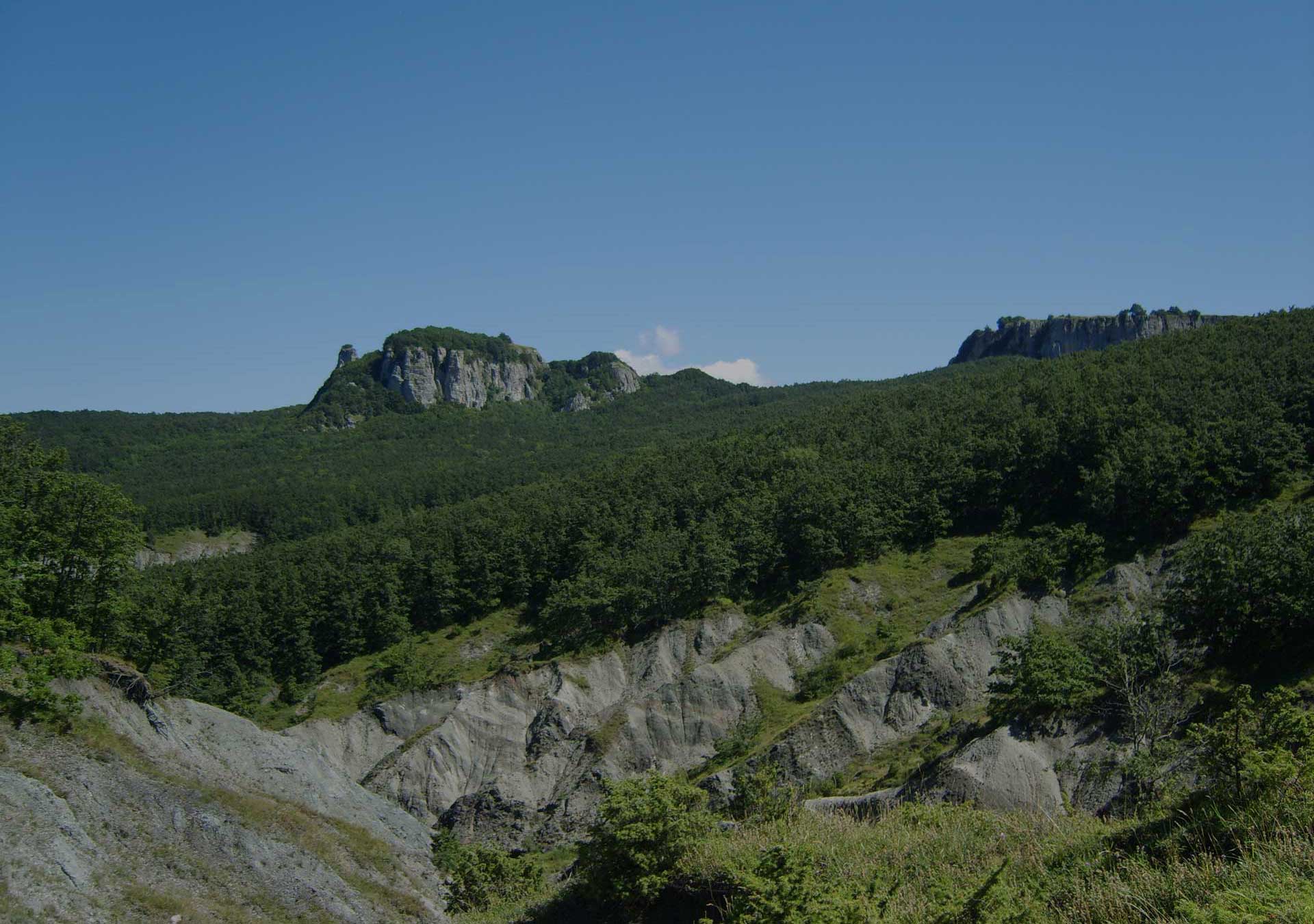
The Park
a unique heritage to discover
Farmhouse Sasso Simone Simoncello is immersed in the beautiful landscape of the central Apennines, in a place that is the natural gateway to the Protected Area.
The Nature
The Sasso di Simone and the Simoncello are two curious truncated cone-shaped mountains, which certainly do not go unnoticed in the eyes of those who travel through this stretch of Apennine ridge. Their position, closer to the Adriatic Sea than to the Tyrrhenian Sea, coincides with the eastern tip of Tuscany, penetrating the Emilia Romagna and Marche regions. The Tuscany Nature Reserve protects the entire Sasso di Simone and the surrounding clayey reliefs, up to Simoncello, forming a single complex with the neighboring Sasso Simone and Simoncello Regional Park in the Marche-Romagna area.
The environment shows the signs of an active but slow geological evolution: the hill-mountainous landscape consists of the limestone massifs of Sassi Simone and Simoncello. The area around the Sassi is occupied by a 800 acres wooded area dominated by a turkey oak: the Cerreta del Sasso, the only one of its kind, is a mixed oak wood among the largest in Europe. The forest also houses other species of trees: beech, hornbeam, maple, ash, sorghum and holly. Among the most interesting herbaceous species are the mountain cornflower, the martagon and orange lilies, the carlina, the mountain Valerian and the three-leaved Anemone.
It is only with the changing seasons that you can truly appreciate the beauty of the natural environment: spring brings the colors of wild orchids to the meadows, the summer is lush in the woods, the autumn smells of mosses and mushrooms while the winter covers the landscape with a pure white blanket of snow, soon violated by traces of wild animals.
The History
The landscape of the Sassi, which is truly unique in its kind, combines interests of various kinds: a rich historical matrix, documented from the Neolithic, an interesting flora and fauna presence and an unusual geomorphology. In the 1100’s a Benedictine abbey, was built right on the summit of the Sasso, emerging probably on the ashes of a former religious building from the Lombard period.
The abbey, knew flourishing times until the fourteenth century. For its strategic function, the inaccessible plateau of the Sasso was of interest to Malatesta Novello, who decided to create an impressive fortress. In 1520, when the Malatesta due to bad luck began to decline, the Sasso passed first under the Florentine Republic and then to the Medici.
Cosimo dei Medici was so impressed by the places and decided to build a true fortified city, not only for defensive purposes but also for consolidating his dominion in this peripheral area. The construction started in 1566 and in a decade defensive walls, houses and a chapel were built, the headquarters of the Capitanato di Sestino established was in 1575. Various vicissitudes, such as very cold winters, distances and difficult connections with the main centers, prevented from the beginning a functional development of the settlement.
In 1663 the city fortress, already in full decay, also lost its military presidency. Of the Medici utopia today remain the ruins that emerge above the wood vegetation that covers the Sasso. A curiosity: some remains of the ancient abbey of S. Michele Arcangelo, built on the summit of Sasso, were used to embellish a beautiful loggia of a sixteenth-century building right in the village of Case Barboni.
Itineraries
Case Barboni is accessible by walk, horse or mountain bike, also trough hiking trails from different locations in the Sasso Simone and Simoncello Natural Park, set up on the Marche-Romagna slopes, like Miratoio, Passo Cantoniera, Carpegna and San Sisto.
This region is crossed by a dense network of paths that converge on Sasso di Simone, linking Tuscan territory with those of Romagna and Marche.
The main itineraries of the Arezzo area are marked by the letters of the alphabet and follow largely the path of the CAI.
The shortest ones are those that start from Case Barboni, with the possibility of circular paths or diversions, joining those of Casa del Re and Martigliano.
The simplest, but perhaps the most beautiful, scenicly speaking is the itinerary that from Case Barboni climbs to Sasso Simone, crossing the calcareous areas made of “Argille varicolori” (varicoloured clay) along the CAI n. 61 trail, intercepting CAI n. 17 near the landslide below the Sasso. The return can be done by the same way or over Monte della Scura.
Longer trails allow you to visit small villages, places and landscapes of great interest:
- from the west to the east, you can see the ridge path A (CAI n. 17) following it from Miratoio or Poggio Mazzolo and the long but easy path CAI n. 5A, which departs from the maintenance house S. Cristoforo Pass and connects to CAI n. 65 after Poggio delle Campane, maintained at high altitude until reaching Petrella Massana and then Case Barboni.
- Sasso Simone, with its abbey, also set itself as a neuralgic point of the best-known Via Romea, a pilgrimage route between Rimini and Sansepolcro. Sasso di Simone is still a point of reference visible from all directions. The itinerary coincides partially with trails marked by the CAI: the trail 122 on Monte San Paolo and Monte della Valle, 114 from Montecerignone to Poggio Rosso, 107, then 108 from Serra Nanni to Paterno, 119 from Carpegna to Sasso di Simone , 17 and 61 from Sasso di Simone to Monte Scura, 65 to Poggio delle Campane, 5A to Monte Bello, 5 from Sasso Aguzzo to Montelabreve Pass, 89 to 85 between Parchiule and the Vacche Pass, the 4 from the Vacche Pass to Sansepolcro.


